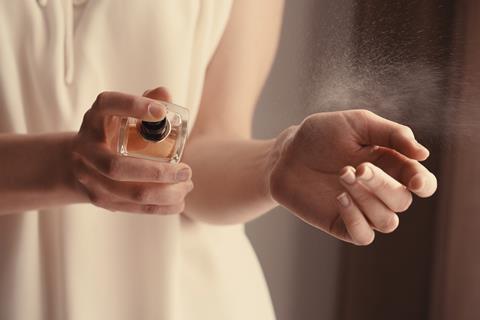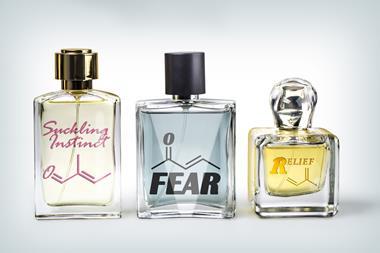Skin lotions and perfumes can disrupt the chemistry of the air surrounding us, although more investigation is needed to understand what, if anything, this means for human health.

Back in 2022, a team of researchers led by Jonathan Williams, an atmospheric chemist at the Max Planck Institute for Chemistry in Germany, stumbled on the fact that the ozone chemistry taking place on our skin generates a sheath of hydroxyl radicals (OH) around us, which oxidise chemicals entering it – our personal oxidation field.
‘We think that the OH chemistry is generated by ozone reacting with your skin – your skin is covered with this molecule called squalene, which is a C30 molecule, a long chain with lots of double bonds, which is oozing out of your skin all of the time to keep it supple,’ explains Williams. ‘The moment the ozone reacts upon those double bonds, it can send into the air another molecule called 6-MHO [6-methyl-5-hepten-2-one, a key OH precursor], which also contains some double bonds, but that flies off into the atmosphere, and when that reacts with ozone further in the air, that’s what generates the OH field.’
In previous experiments, the researchers had been very careful to minimise the presence of any external fragrances. However, in their latest research the team wanted to find out how commonly used personal care products, such as skin lotions and perfumes, could affect the human oxidation field.
To do this, four young adults were first exposed to ozone in a temperature-controlled, stainless-steel chamber, and then the experiment was repeated after the application of a widely used body lotion, or fragrance.
‘There’s a huge suite of volatile organic compounds in the air around us, many of which we emit ourselves, and we measured those with the mass spectrometer,’ says Williams. ‘We’d also adapted one mass spectrometer to measure something called total OH reactivity, which is the total reactivity presented by all molecules in the air to the OH radical. That was a critical measurement, because that enabled us to calculate how much OH was actually being generated around us.’
Williams explains that when you add something else into the mix, like a perfume or a lotion, you are making a change to that system, and in both cases they found that the oxidation field was suppressed. ‘If you put body lotion on your skin, then the area of contact between the ozone from the air and the squalene that naturally occurs on your skin lowers, and that seems to be why the OH field is suppressed when you put body lotion on your skin,’ he says.
The perfume was a different story and, at first, they wondered if perfume may potentially enhance the human oxidation field. ‘Perfume is a very fine mixture of chemicals, which is dissolved in an alcohol base,’ explains Williams. ‘Some of the chemicals in that mixture that make the nice smell, we know that they could also produce OH when they react with ozone, a little bit like 6-MHO, so we were wondering whether perfume would even be an enhancer of the field.’
‘But it turns out that the fragrance molecules are at so low a concentration and the perfume is mostly ethanol … and what we were seeing was the ethanol was evaporating off the skin and consuming the OH around us, again suppressing the OH field.’
The application of a fragrance and a lotion together showed that the fragrance affected OH reactivity and concentration for shorter time periods, whereas the lotion showed more persistent effects, consistent with the rate of emissions of organic compounds from these personal care products.
However, what this means for people is not yet understood. ‘The mixtures of chemicals produced in both cases, for many of them their toxicity, or the long-term effects of exposure, are just simply not researched,’ says Williams. ‘So, all we can say is this is a naturally occurring phenomenon around you that creates this field, it’s good that we’re now aware of it, and good that we are now aware that we can change the field by the way we live and the way we apply cosmetics.’
Richard Corsi, an indoor air quality expert at the University of California, Davis in the US, describes the paper as ‘really good’ because it generates more questions to follow up on. However, he says the ‘big question’ is whether the presence of OH radicals around our bodies is a negative or positive thing.
‘You can imagine as we’re exposed to pollutants, this increase in hydroxyl radicals around our bodies is going to chemically react with things that come into our breathing zone, and that might be a good thing if the OH radicals are degrading that pollutant, if it’s a harmful pollutant. But then there are always byproducts from that OH radical reaction that could be transformed into something that’s more harmful to us. So, the oxidation field may have at times a positive effect, at times a negative effect.’
He adds that this is something that should be investigated in more detail. ‘If we find, for example, that suppressing the oxidation field is a good thing for some people – for example, children with asthma – if we could coat their skin with more of these skin lotions, that might be a good thing to protect them, especially on days where you have smog, or elevated ozone days.’
‘I’m not suggesting that that’s the case, but that’s where these kinds of results should drive some further studies to see if there is a strong correlation between the oxidation field and asthma or other diseases.’
References
N Zannoni et al, Sci. Adv., 2025, 11, eads7908 (DOI: 10.1126/sciadv.ads7908)

















No comments yet